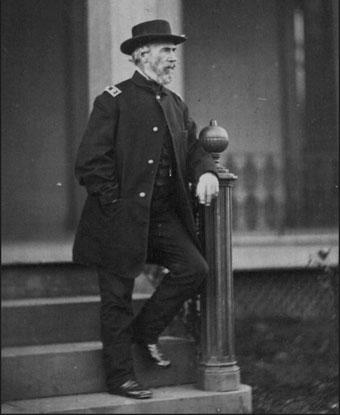Last updated: June 17, 2015
Person
Edwin Vose Sumner

Library of Congress
From the Peninsula to Maryland: Sumner's role in the summer of 1862
When David E. Twiggs was removed from command in March 1861, Abraham Lincoln chose Edwin Sumner as his replacement, appointing him as one of only three brigadier generals in the regular army. This made Sumner the first new Union general created by the secession crisis.
Sumner was initially dispatched to the Department of the Pacific in California, which meant he took no part in the 1861 campaigns. He was, however, brought back east to command a division in November 1861. This meant that Sumner was ideally positioned to take command of one of the new corps when the Army of the Potomac was reorganized in the spring of 1862. Although he was the oldest general in the Army of the Potomac, Sumner led the II Corps throughout the Peninsula Campaign and the Seven Days Battles.
Despite performing poorly during the Battle of Williamsburg on May 5, Sumner's initiative in sending reinforcements across the dangerously rain-swollen Chickahominy River prevented a Union disaster at the Battle of Seven Pines and garnered Sumner a brevet promotion to Major General.
When the Army of the Potomac pulled away from Richmond, Sumner's II Corps sailed from Fort Monroe back to Washington, where they awaited orders. On August 27 Halleck extracted a promise from McClellan to immediately advance Sumner's and Franklin's corps to support Pope at Manassas, but later that same day McClellan cancelled the orders of march. He instead held Sumner in Washington for the next three days while the Second Battle of Manassas (Bull Run) was being fought.
On the 29th Halleck again ordered Franklin and Sumner to march to Pope's assistance early in the morning, but though Franklin moved his men to Annandale, Sumner's corps did not even leave the Washington fortifications.
Sumner remained in Washington until midday on August 30, when his corps finally began marching toward Centreville, arriving on the 31st, the day after the Second Battle of Manassas had ended.
Sumner found himself in the center of controversy in the aftermath of the Battle of Antietam. When he saw the developing fight between the Union I and XII Corps and Jackson's Confederates on the morning of September 17, without waiting for orders Sumner ordered John Sedgwick's division to push forward into the West Woods even as William French's division pushed toward the Confederate center. Though French's attack met with some success, the advance of Sedgwick's division was devastated by a Confederate counterattack, and Sedgwick and his men were forced to retreat back to the position from whence they had started their advance, sustaining over 2,200 casualties.
This action has earned Sumner criticism for numerous reasons: the recklessness of the attack, his lack of coordination with the other corps commanders, personally accompanying Sedgwick's division into the fight, poor reconnaissance of the area before moving forward, his failure to secure his flanks as the division advanced, and losing contact with and control of French's division during the advance.
